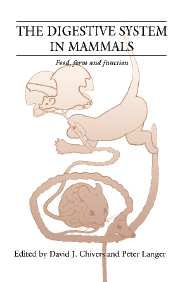Book contents
- Frontmatter
- Contents
- List of contributors
- Preface
- Part I Introduction
- Part II Food
- Part III Form
- 12 The form of selected regions of the gastro-intestinal tract
- 13 Categorisation of food items relevant to oral processing
- 14 A direct method for measurement of gross surface area of mammalian gastro-intestinal tracts
- 15 Morphometric methods for determining surface enlargement at the microscopic level in the large intestine and their application
- 16 Weaning time and bypass structures in the forestomachs of Marsupialia and Eutheria
- 17 Adaptations in the large intestine allowing small animals to eat fibrous foods
- Part IV Function
- Part V Synthesis and perspectives
- Index
17 - Adaptations in the large intestine allowing small animals to eat fibrous foods
Published online by Cambridge University Press: 18 March 2010
- Frontmatter
- Contents
- List of contributors
- Preface
- Part I Introduction
- Part II Food
- Part III Form
- 12 The form of selected regions of the gastro-intestinal tract
- 13 Categorisation of food items relevant to oral processing
- 14 A direct method for measurement of gross surface area of mammalian gastro-intestinal tracts
- 15 Morphometric methods for determining surface enlargement at the microscopic level in the large intestine and their application
- 16 Weaning time and bypass structures in the forestomachs of Marsupialia and Eutheria
- 17 Adaptations in the large intestine allowing small animals to eat fibrous foods
- Part IV Function
- Part V Synthesis and perspectives
- Index
Summary
Herbivores feeding on coarse food have to rely on microbial digestion to be able to use structural carbohydrates of the food. The fermentation can be located in the stomach prior to the part secreting gastric juice or in the large intestine, or both. The fermentation vat in the large intestine consists of the caecum and/or the proximal colon. The term hindgut is commonly used as equivalent for the entire large intestine although embryologically it refers to colon descendens and rectum only (Hofmann, 1991).
The microorganisms of forestomach fermentation attack all available food components coming into the fermentation chamber. This also includes nutrients that could have been digested by the herbivore's own digestive enzymes. Microbial fermentation always leads to energy losses in the order of 10–20% of the available energy. It also often gives rise to nitrogen losses in the form of ammonia production. Hindgut fermenters have the opportunity to digest the available parts of the food before any microbial fermentation. That means they avoid some of these losses.
The mass-specific energy requirement of homeothermic animals is relatively high and related to body mass'’ 025, i.e. the smaller the animal the greater its energy need per unit of body mass. Exceptions are found among monotremes, marsupials, hyraxes and sloths, animals having lower metabolic rates than the average for their size. A 25 g vole, for example, needs about 12 times as much energy per kg body mass as a 650 kg horse. This also means that the vole has to eat at least 12 times as much food as the horse when eating the same kind of food. Consequently the passage rate will be 12 times higher in the rodent.
- Type
- Chapter
- Information
- The Digestive System in MammalsFood Form and Function, pp. 287 - 310Publisher: Cambridge University PressPrint publication year: 1994
- 25
- Cited by



